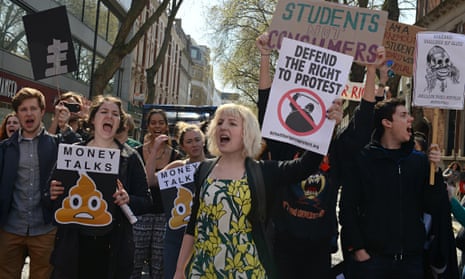More revolting students. More sit-ins. Or “occupations” as they are now called. More sleeping bags and placards. More tweeted slogans. More failed negotiations. More pie-in-the-sky thinking. More money wasted on court proceedings. More muffled mutterings of support from inside their own institution. Just what do these daft young protesters at Central Saint Martins want?
Peace in our time? Free money? All-out revolution? Actually, no. What they actually want is affordable education that is as accessible to as many of their peers as possible.
These are hardly utopian demands – and they are also being made in protests in Holland and Canada. The increasing marketisation of education is the issue. A hundred or so students have been demonstrating outside the Royal Courts of Justice in London as the University of the Arts took out an injunction against 15 of the 80 students who have been occupying the reception of Central Saint Martins for a month.
Art students, always deemed to be the most unworldly of them all, are campaigning about cuts to the foundation courses – but actually they are drawing attention to what is happening to art schools. It’s more than just “cuts”.
Foundation courses are one of the last bits of further education that remain free for young people. Central St Martins say that they will lose 580 places in the next two years and that they have tried to negotiate with the protesters. Indeed, their correspondence has been transparent and they claim that legal action is a last resort. Maybe so, and I suspect that the students know that many staff within their own college are also pretty horrified at what is happening to their institution. They should all be on the same side against policy makers.
For it is they who have overseen the transformation of our art schools into finishing schools for those that can afford them. The massive influx of Chinese students into our best art colleges should also interest educationalists. While a Chinese, Malaysian or Indian education is often held up as the most rigorous of all, a model we should emulate, art colleges are telling a different story. Innovation, critical thinking and creativity are areas we excel at. An international elite are paying fees to grab some of it.
Over the years I have taught at Saint Martins, working with students from graphics, fashion, product design, industrial design, film, painting and sculpture. Those who now say there are not different models of learning and it must all be done by rote have clearly never taught a class of designers. Often these students are fizzing with ideas, but they’re not always brilliant at reading books or writing essays. It was my job to get them to do it and I had to learn how to. The pleasure of witnessing their visual, collaborative and often quite lateral intelligence was a brilliant education for me. To see ex-students’ names in magazines still gives me a thrill. Those who imagine art schools are some kind of easy option – a luxury, a place of froth – haven’t been near one lately. Most of the young people there are pretty entrepreneurial. They have to be.
Art schools are at the forefront of the sustained attack on humanities that Marina Warner has written so brilliantly about. One of the slogans of those occupying Central Saint Martins is simply this: “We’re an art school not a business.” Languages, humanities, social sciences and particularly arts are subject to huge losses in funding and are expected to do just this: become businesses. This is the only model that our politicians understand. Hence we keep being told that the creative industries do employ lots of people. Every film made here requires carpenters and electricians and so on. The argument that art or culture is valuable only when it is monetised is a dangerous one. A false dichotomy between science and art has been set up – first by Labour with the Browne review, and now amplified by the Tories. So Stem subjects (science, technology, engineering, and mathematics) are seen to be financially viable. Which of our ministers has a degree in maths or science I wonder?
Real innovation is coming from the crossover between science and arts. Artists visualise what science models. Cultural production is being dumbed down: art is yoked only to entertainment or the economy. But surely, as the organisation Arts Emergency says: “There is no recession of the imagination.”
An arts education is becoming unaffordable. Few politicians have had one; though Labour’s Kim Howells did (Hornsey College of Art). I met him at a conference at St Martins to discuss the very purpose of art schools. There I also talked to Johnny Vegas (Michael Pennington) about learning to question, and tuition fees. He said: “The ones who can afford it, they don’t need to question – because they have got the trust fund.”
Maths, science and engineering are vital. But so are music, design, architecture, poetry, painting: these are the ways we redraw and remake our shared world. William Morris said: “I do not want art for a few any more than education for a few, or freedom for a few.” But that is exactly where we are going.

